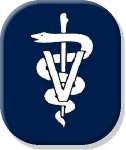Hello once again. As previously promised, I will start regularly describing some of my cases that I've seen over the past few months. To finish where I left off, I have one more interesting case from my orthopedic surgery rotation. A Greyhound came in on one of the last few days of the block with a grade IV/IV lameness (i.e. not bearing any weight) on one of its hind limbs. Normally, when trying to localize a lameness in a dog or cat, they cannot tell you where it hurts. Instead, you need to perform a thorough orthopedic examination to localize the source of the pain. In this Greyhound, however, there was not much need to do this because you could look at the dog and see her problem. The toes on one of her hind limbs were all stuck in flexion, nor could he do much to flex or extend her "ankle". If you look at the back of a dogs ankle, you'll see how there is a bone that sticks out to which the Achilles tendon attaches. This is called the Tuber Calcaneus. Just upon looking at the dog, one could see that the tuber was not sticking out hardly at all. We took radiographs to confirm that the bone was broken.
Now, from what I could tell from the history I received from the owner, the dog suffered the injury while racing 10 months prior to presentation to the vet school. The person who brought the dog in was a Greyhound rescuer who said that the dog went through many homes before getting to them. My guess was that each person who had the dog could not afford to have the dog treated, and understandably so. We took the dog to surgery and secured the bone back into place with a plate and screws. The surgery went well, but performing surgery on Greyhounds makes me nervous. The are sensitive to the drugs used in anesthesia, they have very thin skin, and they are very prone to bleeding more and bruising. Nonetheless, these factors should only make one more cautious before moving forward. The dog needed surgical repair in order to use its leg again. Thankfully, the procedure went well and the post-operative radiographs looked ideal, but the dog really swelled and bruised over the next few days.
While the above result sounds gruesome, the surgeon on the case assured me that the dog would likely do well. I had trouble believing that, but he's had decades of experience so I trusted him. Regardless, it could only help since the dog wasn't placing any weight on the leg since its toes were stuck in flexion. The only catch is that it would take weeks to months for the tendons and ligaments in its lower leg to stretch out and return to normal after receiving some physical therapy.
Unfortunately, I do not know how this case turned out because my following block, Small Animal Internal Medicine, left me no time to do follow up on my previous cases. As I will describe in my next couple posts, I practically lived at the vet school for 3 weeks. Till next time...
Subscribe to:
Post Comments (Atom)


1 comment:
Dogs have been man’s most faithful companion, since early times. Today, they are routinely trained to help differently abled personsTrained Home Protection Dogs | Personal Protection Dogs for Sale
Post a Comment